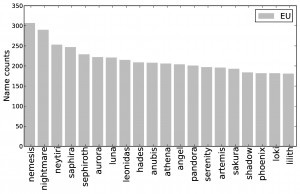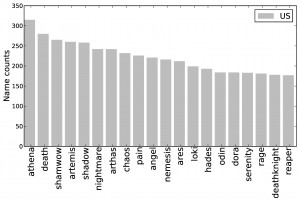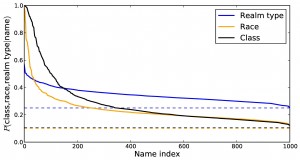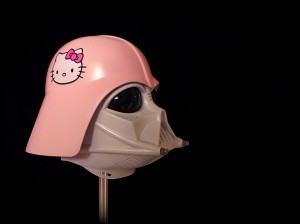· 7 min read
Fun Facts about World of Warcraft Character Names
Anders Drachen
Anders Drachen, Ph.D. is a veteran Data Scientist, Game Analytics consultant and Professor at the DC Labs, University of York (UK).
Sometimes as a game analyst, you get to run analyses that do not have an immediately useful application, but which are just fun (yes, data analysis can be fun). Such exercises sometimes begin when people get together socially after a long day and start speculating. This was also the case when one day, a bit over a year ago at a conference, a couple of analysts from the industry and academia started the customary ritual of bragging about the accomplishments of their characters in various MMOs:
“Yea, HealBot was among the first 10 to hit the level cap on [insert name of vastly popular and elite server in popular MMO]” one might say, with a colleague chiming in: “ha! As if that is an accomplishment. NecroZeus has 45,000 hit points [a lot] and is top-ranked in [insert suitably impressive guild name in major commercial MMO]”. “Your characters have barely matured from their diapers gentlemen – ZonkarTheMighty was first player ever to get the [insert name of impressive epic loot requiring dozens of player to coordinate their efforts]” – and so forth and so forth.
This lively debate unexpectedly led to a discussion about character names, and a speculation that there might actually be some sort of pattern in how we as players name our characters. For example, it was wondered why in e.g. World of Warcraft, Paladins were always called something along the lines of “Healbot”, Warlocks cool-sounding names like “Bloodmaster” and blood elves – irrespective of class – fancy names such as “Moonlight”. Taurens, it was argued, usually had names that deserved to have gravimetric force on their own, like “Mortar” or “EarthStomper”. It was decided to investigate whether these hypotheses had any merit.
Enough exposition, get on with it!
The next step involved getting a hold of a ridiculous number of character data from World of Warcraft. About 18 million in total. This is a lot. And it made analysis cumbersome, so it was cut down to about 8 million, subsampled from the 50 biggest guilds on US and EU servers.
The first result that became apparent was that players in World of Warcraft are incredibly talented at creating unique names. Characters with the same name can exist on different servers, so the mind-boggling 3.8 million unique names found in the dataset was not expected. This is more diverse than real-world names, despite the naming restrictions in World of Warcraft. Why this diversity occurs we can only speculate about, but it may relate to a desire to build a unique character – and the name is the only truly unique feature in World of Warcraft. On average, 58% of the names were unique – but on the Role-Playing servers 83% were unique – whether that speaks for the added creativity of RP’ers vs. those that favor PvP is unknown however.
Moving on, it is also evident that there is a relationship between the class and race of a character and the name selection. Looking at the most popular names for the different races and classes in World of Warcraft, there is virtually no overlap. For example, Mages have different names than Warlocks, and Tauren are named differently than Blood Elves. Perhaps unsurprisingly, name frequencies follow power laws. For reasons unknown, Mages have a much higher variety of names than any other class. Any speculations as to why is welcome.


In fact, isomap projection revealed that the “pretty” races (humans, blood elves, draenai, etc.) and the “bestial” races (orcs, tauren, undead, trolls – and gnomes and dwarves) formed two distinct groups. I.e. people name pretty characters very differently from the bestial ones (or however you want to define these races). Strangely, the otherwise non-bestial Gnomes and Dwarves map with the bestial races. This results leads into speculations about some uncomfortable aspects of human psychology that we will leave alone for now.
Isomap projection also revealed that character names on US and EU servers mapped differently. And that characters on RP realms mapped differently than those on PvP realms (with PvE and RP-PVP and other hybrids mapping with either parent group or in the space between). Interestingly, names for RP servers overlap across the US-EU divide.


You mentioned prediction?
Prediction is one of the most common goals of data mining player behavior, and somewhat surprisingly to the analysts involved, estimations of the conditional probabilities of a given class/race/server type/level/etc. given a particular character name actually revealed that some names are very good predictors. Class and race emerged as the overall best predictors of names. This is especially the case when names are inspired by popular media, books, film, mythology etc. – more on this below.

So, how do people come up with these names?
Not satisfied with patterns, the 1000 most common character names in World of Warcraft were taken through a pain-staking process of manual examination and source of inspiration identification. The method used was manual semantic coding. This is a fancy way of saying the categories were made up as the names were investigated. What was found was that real-world, vanilla names such as Sara, Mia, Daniel and so forth were the most common (186 names). Mythology, notably Greek, accounted for 164 names. Popular culture (notably Japanese manga and the characters invented by a certain Mr. Wheedon) accounted for 174. Fantasy literature, with Tolkien ruling supreme, accounted for 39 names. A lot of the most popular names were in direct breach of the terms of use of World of Warcraft. Many names were basically copies of important NPCs. About 300 of the 1000 most popular names could not be classified. These were names consisting of verbs or nouns of unspecified nature, however, they can be categorized based on semantic content. For example:
- ”Negative”: Nightmare, Sin, Fear, Requiem
- ”Positive”: Hope, Love, Pure
- ”Neutral”: Who, Moonlight, Magic, Snow
The names with negative semantic connotations were six times more common than those with positive connotations. Does this mean gamers are depressed? Or do “dark” names just sound cooler?

Okay, but is this useful?
Yes and no. It cannot be claimed that the analyses provided direct insights in how to improve the design of World of Warcraft nor of the players. It does provide insight into the players though. Irrespective, this kind of work falls squarely into the explorative and non-goal driven category of game analytics processes discussed here. However, without curiosity-driven research, we would not have the laser, the microwave or teflon. This new game analytics book includes several examples of curiosity-driven game analysis leading to important conclusions. So this is definitely not an argument against being explorative and creative in analytics.
Perhaps the most intriguing part of the work is the hints that it may be possible to predict some aspects of play behavior or even personality of people based on their character names. Player profiling is another area where including names could be of interest, notably in sparse-data situation.